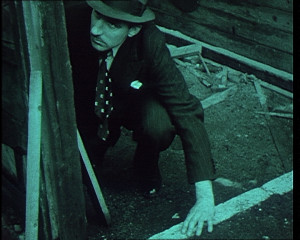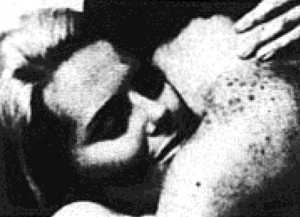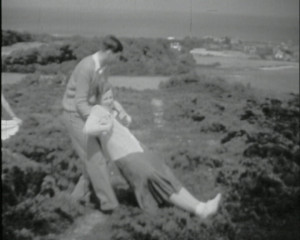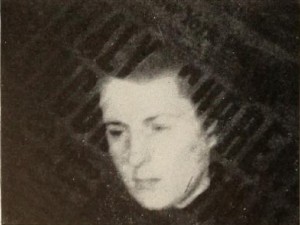"Pipe Dreams, by Joseph Dephoure, ACL, and Edward Atkins, ACL, is ranked among the year's ten best because of its considerable triumphs over dramatic and technical difficulties. Through the imagination of its producers, a small cast, simple settings and moderate footage have been used to tell a big story, rich in pictorial effect. Dreaming that he has murdered his unfaithful wife, a young man sees in prospect the swift and fearful course of his life to the waiting gallows. The murder, the trial, the death cell and the hanging are represented in large part only by the imaginative and striking use of shadows of the real scenes. Occasional straight shots are heightened in effect by unusual angles and dramatic lighting. Sensitively planned, smartly executed and deftly cut, Pipe Dreams makes its simple story exciting and forceful." Movie Makers, Dec. 1933, 500.
"Apex Motion Pictures are busy on a story which entirely ignores the ordinary narrative channels: this production, they tell me, is right off the beaten track. In fact, I am told that this is a sincere attempt to produce the first real amateur story film, i.e. one in which the whole of the work is carried out cooperatively. This effort is to be issued as “Poor Jenny is Aweeping”, and Leslie Wood passes me the information that this film deals with a side of life which, though it affects everyone, has never, so far as he is aware, been handled in a book, play, or film. What is more, although A.M.P. claim to be the first with amateur talkies, they have now gone silent. Apex Publicity also states that Kurt Camerona, their cameraman, is playing the Rev. Cecil Teed, and is giving us something new in characterisation" (Head 1932: 21).
"noteworthy for having introduced yet another technical advance invented by Apex cameramen – “the dolly twist”, as it has been christened. The camera is turned over and over, gradually slowing down and remaining stationary, at the same time the dolly goes towards or away from the subject being photographed. Like all worth-while innovations, however, the shot was created to fit the peculiar demands of certain sequences of the film; it has not been dragged willy-nilly into the film simply for the novelty of the stunt. It is particularly valuable in films of the macabre genre" (HMHT 1933: 297).

A Mysterious short film surrounding a building company's bid for a contract to build a town hall.

"Prime Time is a film that is different because of the way it was put together by Herbert W. Smith of Concord, N.H. That's why it won the MPD Golden Scissors Award for editing. It lasts only three minutes, but it is fast, gets to the point and that's it. Splendid color, beautiful people, handled differently and a few other innovations. It's a war story, a love story, a sad story and a short story" PSA Journal, Nov. 1969, 57.

"This is an acted melodrama which takes place on Runton Heath and Incleborough Hill. The captions tell the story line" (EAFA Database).
"This amateur film attempts to portray conflict within a religious sect where blind adherence to a selfish demanding leader is compared to the freedom offered by progressive contemporary society" Library and Archives Canada.
"The story concerns a girl who, during her husband’s absence in the East, takes a lover. The husband returns home unexpectedly, and, in a heated scene, threatens the lover with an automatic. Unfortunately for him this expansive gesture is witnessed by a tramp. The tramp thinks he had better retreat. As he hurries from the scene he hears a shot ring out and returns to find that the lover has been killed. He reports to a policeman, with the result that the husband is arrested, tried, and condemned to death. Dramatic Climax - With feminine perversity the wife now realises that it is her husband who she really loves, and implores her sister’s fiancé, a member of the C.I.D., to save her husband, whom she believes innocent. He promises to do his best, and, on fuller investigation, finds a sodden letter near the spot where the murder was committed. On making enquiries he finds that a man has recently been lodging at the address given on the envelope, who had just returned from America, and had disappeared on the day of the murder. When finally arrested the man tells of a private vendetta with the lover and of his determination to be avenged. A witness to the quarrel, he shoots the erstwhile friend just after the quarrel with the husband. The final scenes lend themselves to a thrilling climax. The final shot portrays the face of the murderer as he discharges his gun point blank at the audience" (M.A.L.B. 1931: 6).

"Return from Fire, as defined by its producer, Dr. W. Lynwood Heaver, is the "biography of a mental breakdown." In its opening we meet a boy and girl idyllically in love. But the clouds of war fall across their summer sunshine, the young man is called up and, in a short time, is announced as missing in combat. It is then that the fires of apprehension, misery and terror sear into the girl's mind. How modern psychiatry serves, at last, to recall her from this self inflicted limbo is the climactic denouement of Dr. Heaver's drama. The conception of Return from Fire is imaginative and exciting. The acting and its correlative direction are excellent throughout. A provocative musical score contributes markedly to the maintenance of dramatic tension. Dr. Heaver's camera work, rising occasionally to heights of cinematic imagination, is sound, satisfying and suggestive of still greater things to come. Put down his name as one to watch!" Movie Makers, Dec. 1945, 494.
"A man is shot, the gun is handed to an innocent lad who is promptly grabbed by a police officer. Rex Malloy is asked to defend the young man. Money is available to Rex if he will not defend the boy. Rex is much concerned, money vs. professional conscience. In a moment of sleep, head on hands on the desk, his subconscious finds a way to remind him of his duty" PSA Journal, Nov. 1960, 42.
Total Pages: 12